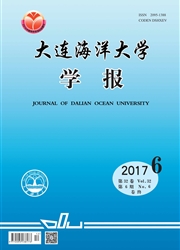

 中文摘要:
中文摘要:
为了给北方海水鱼虾蟹苗提供一种新的活饵料,在海水中进行了大量培养西藏拟[氵蚤]Daphniopsis tibetana和将该涵投喂红鳍东方[鱼屯]Fugu rubripes的试验。结果表明:西藏拟[氵蚤]培育的最高密度为1570~2320个/L,平均日产量为23.0~35.2g/(m^3·d);摄食西藏拟[氵蚤]的红鳍东方[鱼屯]的存活率、体长和体重相对增长率与对照组差异不显著(P〉0.05),饵料系数高于对照组。而日粮却与对照组接近;摄食西藏拟[氵蚤]的红鳍东方[鱼屯]鱼体的高度不饱和脂肪酸(HUFA)中,除C22:6w3(DHA)的含量低于对照组外,其余脂肪酸的含量均高于或与对照组相当。同时也讨论了影响西藏拟[氵蚤]密度和产量的生态因子及西藏拟[氵蚤]的营养价值问题。
 英文摘要:
英文摘要:
Experiments on mass culture of water fleas ( Daphniopsis tibetana) were conducted in a 25 - L plastic tank in sea water in a laboratory (S =20) and the water fleas was fed redfin puffer(Fugu rubripes) to supply a new live food for marine larval fish, shrimps and crabs. The results showed that the maximal density of the water fleas achieved 1 570 -2 320 ind./L with the average daily production of 23.0 - 35.2 g/( m^3 · d). The fish fed the water fleas had the same survival rate and relative weight gain and length increment rate as the fish in the control group. There was significantly higher food conversion ratio in the fish fed the water fleas than that in the fish in the control groups while the rations were the same in all groups. There were higher or same fatty acid levels in the fish fed the water fleas than those in the fish in the control group except for C22:6w3 (DHA) level in HUFA. The ecological factors influencing survival and density of the water fleas and its nutritional value were discussed in detail.
 同期刊论文项目
同期刊论文项目
 同项目期刊论文
同项目期刊论文
 期刊信息
期刊信息
